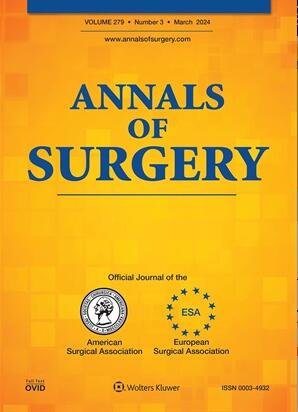Frailty and Survival for Diagnoses Feasibly Managed Operatively or Nonoperatively.
IF 7.5
1区 医学
Q1 SURGERY
引用次数: 0
Abstract
OBJECTIVE Compare outcomes, stratified by frailty, of patients with eight common conditions with plausible operative and nonoperative management strategies. SUMMARY BACKGROUND DATA A surgical pause, evaluating potential adverse outcomes among frail patients, improves postoperative outcomes; however, the outcomes among patients opting for nonoperative management are unknown. METHODS In an observational cohort study across a multi-hospital healthcare system including adults presenting to outpatient surgical clinics (2016-2023) for evaluation of eight conditions feasibly managed operatively or nonoperatively as defined by modified Delphi consensus. In a landmarked analysis, we compared 2-year survival by management strategies across frailty categories (robust, normal, frail, very frail) as defined by the Risk Analysis Index (RAI). Secondarily we compared 365-day hospital free days (HFD-365), postoperative length of stay, and discharge disposition. RESULTS Among 49,169 patients (mean±SD age, 60.4±14.6 y; 54.6% female), operative management was associated with lower observed and adjusted mortality (1.3% vs 2.5%; aHR=0.55 [95% CI, 0.47-0.66], P<0.0001) overall and among all frailty categories expect the very frail (8.1% vs 12.1%, P=0.1). Additionally, operative management was associated with fewer HFD-365 again overall which was specifically prominent among the very frail (median 365 [IQR, 358-365] vs 361 days [IQR, 357-363], P<0.0001). Postoperatively, frailty portended more protracted recoveries with greater postoperative lengths of stay (1.7±2.6 vs 1.2±2.1) days, P<0.0001) and fewer discharges home (370 [85.1%] vs 5,087 [91.8%], P<0.0001; odds ratio=2.0 [95%CI 1.5-2.6]). CONCLUSIONS Considering the protracted postoperative recovery of very frail patients, nonoperative management might be the preferred treatment option for those presenting with these eight clinical conditions.虚弱和生存诊断可行的管理手术或非手术。
目的:比较8种常见疾病患者采用合理的手术和非手术治疗策略的结果,并按虚弱程度分层。暂停手术,评估体弱患者的潜在不良后果,改善术后预后;然而,选择非手术治疗的患者的预后尚不清楚。方法在一项观察性队列研究中,在一个多医院医疗保健系统中(2016-2023年),包括在门诊外科诊所就诊的成年人,评估根据修正德尔菲共识定义的8种可行的手术或非手术治疗条件。在一项具有里程碑意义的分析中,我们比较了由风险分析指数(RAI)定义的不同虚弱类别(强壮、正常、虚弱、非常虚弱)的管理策略的2年生存率。其次,我们比较了365天的免费住院天数(HFD-365)、术后住院时间和出院处置。结果49169例患者(平均±SD年龄,60.4±14.6 y;54.6%女性),手术管理与较低的观察死亡率和调整死亡率相关(1.3% vs 2.5%;aHR=0.55 [95% CI, 0.47-0.66], P<0.0001),除非常虚弱者外,所有虚弱类别的aHR均为0.55 (8.1% vs 12.1%, P=0.1)。此外,总体而言,手术管理与HFD-365减少相关,这在非常虚弱的患者中尤为突出(中位数365天[IQR, 358-365] vs 361天[IQR, 357-363], P<0.0001)。术后,虚弱预示着更长的恢复时间,术后住院时间更长(1.7±2.6 vs 1.2±2.1)天,P<0.0001),出院次数更少(370 [85.1%]vs 5087 [91.8%], P<0.0001;优势比=2.0 [95%CI 1.5 ~ 2.6])。结论考虑到非常虚弱的患者术后恢复时间较长,非手术治疗可能是这8种临床症状患者的首选治疗方案。
本文章由计算机程序翻译,如有差异,请以英文原文为准。
求助全文
约1分钟内获得全文
求助全文
来源期刊

Annals of surgery
医学-外科
CiteScore
14.40
自引率
4.40%
发文量
687
审稿时长
4 months
期刊介绍:
The Annals of Surgery is a renowned surgery journal, recognized globally for its extensive scholarly references. It serves as a valuable resource for the international medical community by disseminating knowledge regarding important developments in surgical science and practice. Surgeons regularly turn to the Annals of Surgery to stay updated on innovative practices and techniques. The journal also offers special editorial features such as "Advances in Surgical Technique," offering timely coverage of ongoing clinical issues. Additionally, the journal publishes monthly review articles that address the latest concerns in surgical practice.
 求助内容:
求助内容: 应助结果提醒方式:
应助结果提醒方式:


